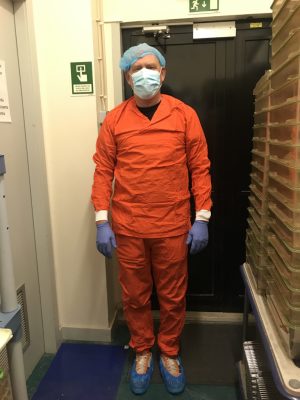Iron is one of those things you—and most life forms on the planet—can’t do without. But how does this essential nutrient help your body fight off pathogens like the foodborne parasite Toxoplasma gondii?
Through consumption of undercooked meat or other contaminated food, T. gondii infects approximately one-third of the world’s human population.
It’s one of the most successful pathogens on the planet, says Jason Gigley, Fulbright scholar and UW associate professor of molecular biology. Once a host contracts T. gondii, the parasite cannot be cleared, instead remaining latent inside neurons and other cells. For people who are immunocompromised, the lurking parasite can cause serious illness, especially if it re-activates in the brain.

While T. gondii is highly sensitive to iron availability, how this sensitivity affects immune responses is not clear.
“Iron is well established in what’s called innate nutritional immunity. Pathogens are stealing iron from the host, the host is trying to steal it back—there’s this tug of war going on,” Gigley explains. “But when you look at fundamental immunology—understanding how iron can regulate immune responses—not much is known.”
In spring 2022, Gigley traveled to Portugal to collaborate with disease tolerance experts in the Instituto Gulbenkian de Ciencia outside Lisbon. With the help of his colleagues, Gigley conducted a series of experiments investigating the role of iron in nutritional immunity and disease tolerance in mice infected with T. gondii.
Disease tolerance is what Gigley describes as “the other side of the immune response.” While immune responses target the pathogen, disease tolerance helps you tolerate inflammation, minimize tissue damage, and survive the infection.
To test the effects of iron availability on immune responses and disease tolerance, researchers genetically modified mice to manipulate how their cells processed iron. The first round of experiments focused on mice lacking a gene required for iron export in cells that support early immune responses. A second set of experiments examined mice lacking a gene required for iron import.
Performance was tracked using daily body weight, body temperature, blood glucose level, disease score (rated on a scale of 1–5), and survival rate.
Using these metrics to compare the modified mice to unmodified mice, the researchers concluded that iron import and export is important in establishing nutritional immunity to T. gondii.
Specifically, they found that mice unable to export iron fared worse compared to the control group, which could still import iron. Mice that could not import iron at all fared even better than the control group.
Whether iron import and export influence disease tolerance during T. gondii infection is still unclear, and Gigley notes that these experiments were the first to assess disease tolerance during T. gondii infection.
Back in Laramie, Gigley has continued his research on immunity. He looks forward to expanding the research partnership with Instituto Gulbenkian de Ciencia and facilitating opportunities for student exchange programs.
Gigley’s research in Portugal was funded by a Global Perspectives grant from the UW College of Agriculture, Life Sciences and Natural Resources and a Fulbright Scholarship. To learn more, contact Gigley at jgigley@uwyo.edu or (307) 766-6151.
This article was originally published in Reflections 2023 magazine, the College of Agriculture, Life Sciences and Natural Resources annual research magazine.




